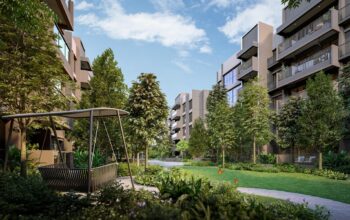It’s one thing to decide to plant a tree in your yard. It’s another to decide which tree you want. The decision becomes even more difficult when you have limited space to work with. If this is your plight, no worries! You can always plant beautiful trees that grow up, not out.
Columnar trees (narrow trees with an upright shape) are perfect for small gardens. They are also a safer bet for larger yards, as there is no risk of them outgrowing the space and needing removal or expensive maintenance. Their slender shape gives them a neat and crisp appearance, which instantly makes your yard look much more elegant. Most of these trees are also known for their vibrant colors, especially during autumn. To determine which columnar tree is the best choice for your yard, be sure to contact professional arborists at Mr. Tree Services.
Here are our top picks of trees that grow up, not out:
1. Sky Pencil Holly
Sky Pencil holly, scientifically called Ilex crenata, is an evergreen columnar tree that has beautiful light green leaves that darken over time. As the name implies, the tree grows to be tall (up to 10 feet) and thin (2 to 3 feet wide) like a pencil, making it perfect for small spaces. Sky Pencil holly shrubs grow quite well in plant pots and containers, so you can use them as decor pieces indoors or frame the door to your home. Better still, they can be placed on your deck or patio to make a sophisticated statement. The leaves aren’t sharp at all so you don’t have to be extra careful around them.
The best thing about this tree is that it is low maintenance. It will grow well in almost any type of soil as long as it is watered frequently, especially in the early growth stage. Because it is so easy to grow, you can plant a bunch of Sky Pencil hollies, close together, to make a lovely privacy screen for your home. While these trees don’t require much care, it is advised to prune them once a year to keep them neat.
2. Italian Cypress
The Italian cypress is one of the most popular trees that grow up not out. They are usually planted in formal gardens or on the sides of long estate driveways. The trees are drought-tolerant and can even withstand forest fires, making them perfect for planting in hot, dry climates. They thrive under full sunlight and can reach a maximum height of 115 feet and a width of 10 feet. Under good conditions, the trees can live up to 150 years.
The leaves of Italian cypress are often used in the production of shampoos because they are rich in glyceric and glycolic acids, which help prevent hair breakage. The trees’ essential oils are also used in the perfume industry.
Although this tree is quite strong and low maintenance, it is susceptible to root rot and cankers. This is why it’s important to hire professional arborists to examine the tree from time to time.
3. Moonglow Juniper
Known for its brilliant silvery-blue foliage that reflects the soft moonlight, the Moonglow juniper is indeed as enchanting as it sounds. The slender shrub has a pyramidal form that flaunts its scale-like leaves and blue berries, which are produced from late spring to late winter. Moonglow juniper is arguably one of the most attractive accent trees for garden and landscape design.
Not only can it be used as an ornamental tree, but it can also be planted for erosion control, privacy screening, and general garden use. It’s a rugged, slow-growth plant that can adapt to wet or dry conditions and tolerates poor soils. Moonglow juniper can reach a height of about 18 feet at maturity and can live at least 70 years under ideal conditions.
4. Lombardy Poplar
Lombardy poplar are fast-growing trees that grow up not out. They can grow at a rate of 6 feet per year and up to a mature height of 60 feet. This is why they are a popular choice for people who are in a rush to make tall privacy screens. It is important to note, however, that this is only a stopgap measure, as the Lombardy poplar usually dies within 15 years due to disease. The trees are deciduous, which means the leaves change color—in this case, from bright green to golden yellow—in the fall.
Lombardy poplar trees grow best in soil with good drainage and in an open space with full sun. They need little pruning since they grow to form a nice, neat structure. However, they require more maintenance because they shed a lot of leaves. There is also frequent limb breakage due to the fragile bark and twigs.
5. Skyrocket Juniper
Like the Moonglow juniper, the Skyrocket juniper also has attractive foliage. The leaves are scale-like and bluish-green, and they bear bluish-gray cones that are not edible. This tree also has a beautiful reddish-brown bark, which adds to its allure. It’s a durable evergreen tree that can transform woodland, wildlife, and urban gardens. If you enjoy birdwatching, this tree will be a wonderful addition to your yard, as it attracts birds and butterflies. Its use as a foundation plant or specimen plant makes it one of the top residential trees that grow up not out.
Skyrocket juniper is relatively easy to grow. It requires a nice sunny spot, as low sunlight makes the tree more susceptible to disease. For best results, it should be planted in slightly acidic, semi-moist soil. It should also have enough space to grow to prevent foliage overgrowth. Freshly planted Skyrocket junipers should be watered twice a week until they become established, then watering can be reduced to once a week.
Whether you’re trying to save space, redesign your yard, or you just love trees that grow up not out, these five trees will definitely meet your aesthetic and environmental goals. For more information about how to plant and care for these trees, contact the experts at Mr. Tree Services.



